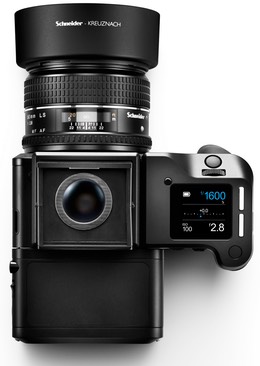(news & commentary)

PhaseOne today announced their new medium format digital camera, the XF, as well as two viewfinders (note waist finder in photo on the right), three backs, and two new lenses.
I’m not exactly a medium format shooter, so I can’t really speak to where the new PhaseOne gear fits into spectrum there, but I have to say that I’m impressed with a number of aspects of the new camera and how it came about. (Disclosure: I’ve declined to accept review bodies from PhaseOne that have been offered to me for the time being, as I don’t feel I could fully give them justice in reviews at present.)
Several aspects of the roll-out of the new XF system stood out to me:
- Clarity of function with the UI. The new touch/control based user interface is right to the point. What Sony didn’t quite get right with the NEX-7’s ti-dials, PhaseOne has figured out. First, PhaseOne is agnostic. You can use the touch interface, or you can use the buttons/dials. Both let you accomplish the same thing. With gloves on in winter, you won’t be using the touch interface, obviously. But in the studio, the touch interface will probably get you what you want faster. Moreover, the touch interface is in the top LCD and in the back; again agnostic as to where you make the setting.
The interface has some useful and interesting nuances, too. Color is used to tell you what was set automatically and what you’ve manually set. You can set arbitrary maximum and minimums to most controls (e.g. set apertures to only be available from f/4 to f/8—e.g. lens sweet spot—rather than the entire available options). Very nice little touches that show that photographers were involved in and driving the design, not semiconductor engineers. - A real system, delivered as a system. You get the camera delivered in a real carrying case (Pelican style), which uses the F-Stop inset system. You don’t just get a camera, you get the back, cables, card reader/card, dual battery charger, sensor cleaning kit, and more. All delivered in a case that you’ll use to carry the system. And that inset system allows you to buy an F-Stop backpack that the inset can be slipped directly into, too. I’ve been using F-Stop packs with and without their inset system—I sometimes use other insets I cobble together—for years now when I’m doing very remote travel and hiking, and they’re good. To some degree, PhaseOne is solving the medium format landscape photographer problem: how do you get the big gear into the wilds (as opposed to the side of the road).
Again, little nuances make for a more useful system: the case has a set of fold-out panels that can be used to set up a laptop viewing station in the field. Plus, of course, PhaseOne offers a tethered option right out of the box with Capture One Pro, and it’s over USB 3.0. But more interesting is that the camera can be configured directly from Capture One pro when tethered, much like Nikon’s long-in-the-tooth Camera Control Pro that costs extra. - Willingness to listen to user base. Kevin Raber at Luminous Landscape pointed out that PhaseOne had implemented one of Michael Reichmann’s suggestions regarding ports, but I see evidence of the company having picked up on other user suggestions, as well. I see lots of changes to the body and back, but virtually every visible one seems to reflect photographic purpose and improvement of experience, not more arbitrary and unmotivated changes.
Even in areas where PhaseOne didn’t meet a user expectation—off-center autofocus, for instance—I note that they’re using the terms “Upgradeable Autofocus,” so it’ll be interesting to see how this progresses in the future.
- Openness to discussing technology. Unlike the Japanese companies, PhaseOne (and to a large degree Leica, as well) seems to be more than willing to let dealers, reporters, and even some users talk directly to engineers, and to let the engineers actually discuss the technologies in the camera and why certain decisions were made.
I can vouch for the fact that every question I’ve had about PhaseOne’s products in the past few years has been met with a direct and complete answer from an appropriate person within the organization. - Modularity. To a large degree, most medium format cameras have always been modular, but the return of the waist level viewfinder with matrix metering and the way this new body, finders, and digital backs communicate seems to indicate that PhaseOne has upped their game in terms of building a system that will better handle future upgrades. The whole system seems to have the more modern approach I’ve been advocating in camera design for some time now.
What I don’t see is more ability to program IPTC data into the camera itself. I suspect that PhaseOne sees the tethered studio shooting option as just allowing the user to do keyboarding and other data entry via Capture One Pro as they shoot, but we really ought to be able to pre-load data into the camera before we take it out into the field for shooting, and it would be even better if we could then tag images from pre-loaded keyword sets. But who knows, considering bullet #3, above, maybe PhaseOne will read this and add that option ;~).





